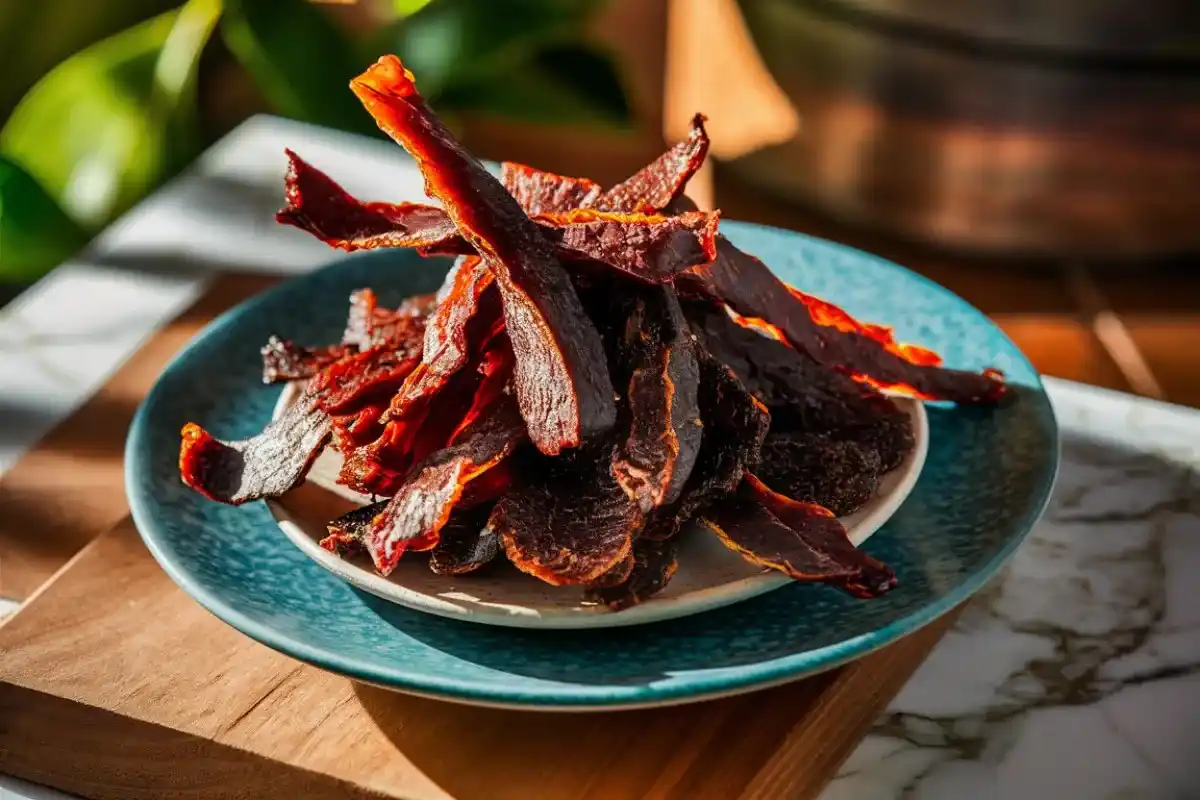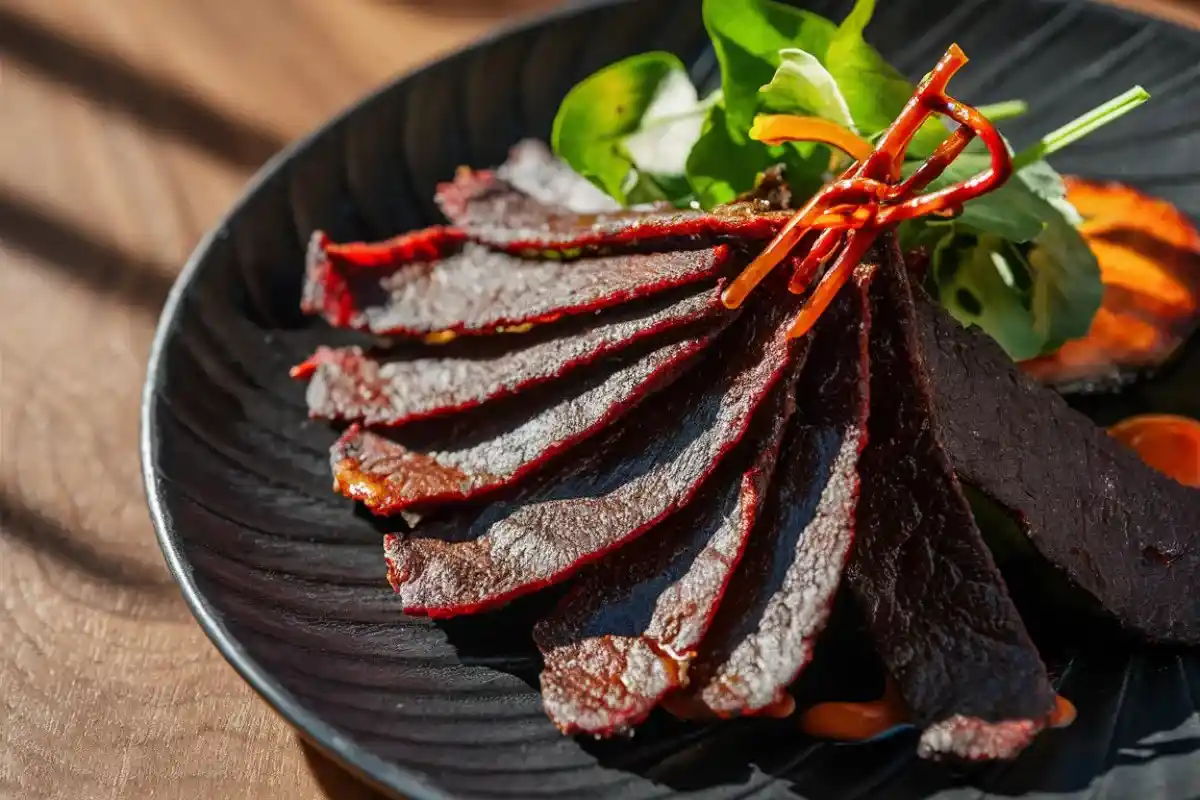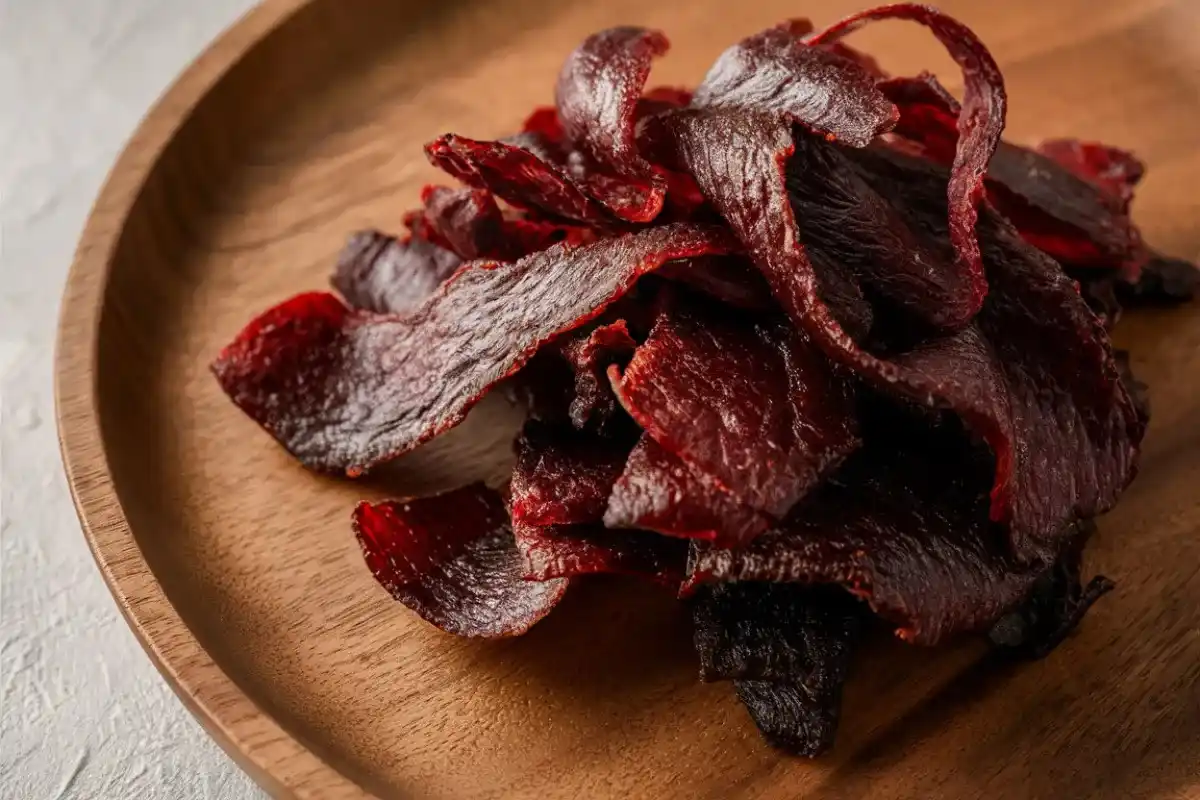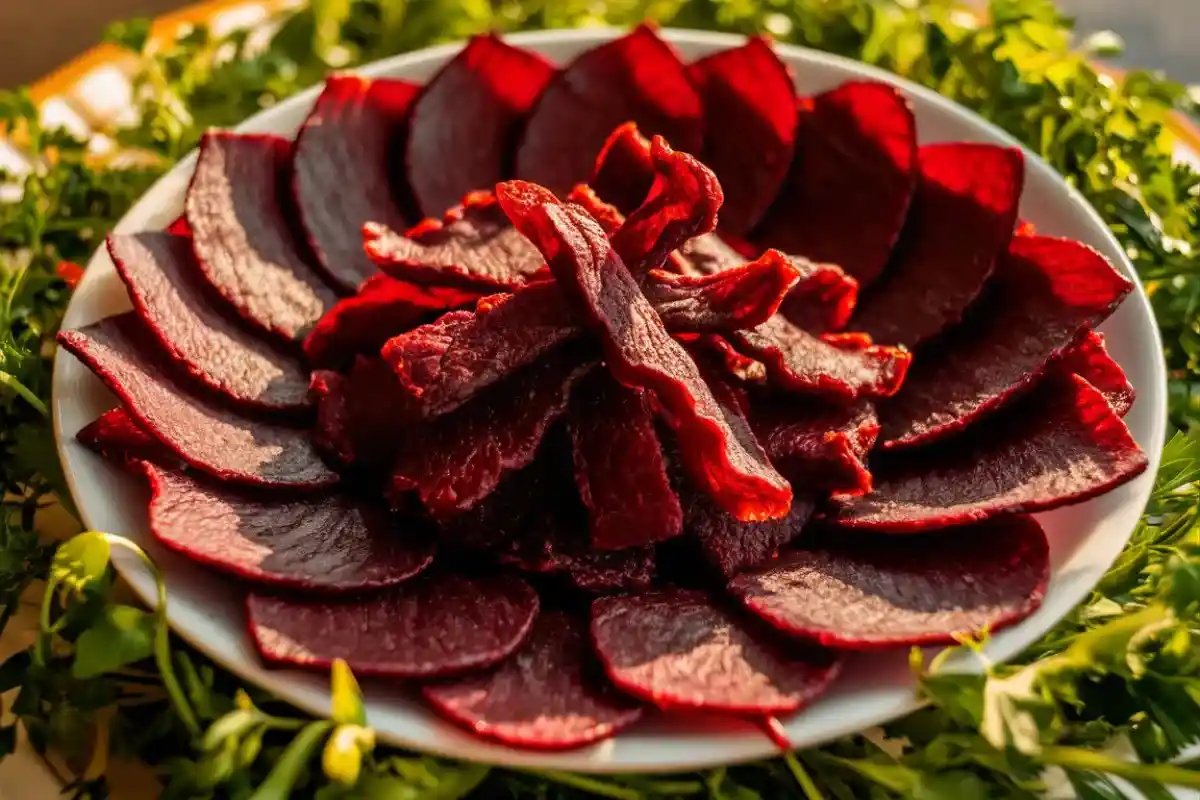Jerky, a popular and convenient snack made from dried meat, is celebrated for its long shelf life and portability. While jerky is known for being a durable food item, its longevity can vary significantly depending on several factors. Knowing how long jerky lasts unopened is essential for ensuring that you enjoy it at its peak quality. This comprehensive guide will explore everything you need to know about the shelf life of jerky, from the types of jerky to best storage practices and more.
Factors Influencing How Long Jerky Lasts Unopened

The shelf life of unopened jerky is influenced by several factors, each playing a critical role in determining how long jerky lasts unopened:
1. Type of Jerky: Does Store-Bought or Homemade Last Longer Unopened?
The type of jerky whether it is store-bought or homemade significantly affects its shelf life.
- Commercial Jerky: Store-bought jerky usually contains preservatives like sodium nitrate that extend its shelf life, making it last anywhere from 6 to 12 months. Additionally, commercial jerky is often vacuum-sealed, which prevents moisture and air from entering the packaging, both of which can lead to spoilage. Many brands also include an oxygen absorber packet to further preserve freshness. Store-bought jerky typically has a longer shelf life due to these added preservatives and packaging methods designed to enhance longevity.
- Homemade Jerky: Homemade jerky, on the other hand, does not contain the same preservatives found in store-bought varieties. As a result, it typically has a shorter shelf life, generally lasting between 1 to 2 months when stored in optimal conditions. Because it lacks commercial preservatives, homemade jerky is more prone to spoilage, especially if not stored correctly. It is crucial to keep homemade jerky in airtight containers or vacuum-sealed bags to maximize its shelf life.
2. Ingredients That Affect How Long Jerky Lasts Unopened
The ingredients used in making jerky also play a crucial role in determining how long it will last.
- Natural Preservatives: Jerky made with natural preservatives like salt, vinegar, and certain spices can have an extended shelf life. These ingredients help inhibit the growth of bacteria and mold, which can cause spoilage. Salt, for example, is a natural preservative that draws moisture out of the meat, reducing the risk of bacterial growth. Similarly, vinegar has antimicrobial properties that help prevent spoilage.
- Artificial Preservatives: Many commercial jerky brands use artificial preservatives, such as sodium nitrate or sodium erythorbate, to extend shelf life. These additives prevent the growth of harmful bacteria, like Clostridium botulinum, which can thrive in low-oxygen environments like vacuum-sealed packages. Artificial preservatives can help jerky last for up to a year or more, making them a key factor in the longevity of commercial products. To know more about this preservative and its role, refer to what is sodium nitrate and why is it used in preserved foods?.
- Flavorings and Additives: Additional ingredients such as sugar, honey, and various flavorings can affect the shelf life of jerky. While these ingredients can enhance flavor, they can also introduce moisture, which may reduce the overall shelf life. For example, sweetened jerky might attract moisture from the environment, leading to a shorter shelf life if not stored correctly.
3. How Packaging Affects How Long Jerky Lasts Unopened
Packaging and storage methods are critical to ensuring the maximum shelf life of jerky.
- Vacuum-Sealed Packaging: This method is one of the most effective ways to prolong the freshness of jerky. By removing air from the package, vacuum-sealing helps prevent oxidation and moisture, which are the primary causes of spoilage. Vacuum-sealed jerky can last up to 12 months or more when stored in a cool, dry place. This packaging is often accompanied by oxygen absorbers, which further enhance the product’s shelf life by eliminating any residual oxygen.
- Alternative Packaging Methods: While vacuum-sealing is ideal, other packaging methods can also help extend the shelf life of jerky. Storing jerky in mason jars or dry cans, for example, can be effective for medium-term storage. To dry can jerky, place the pieces in a sterilized jar, seal it tightly, and store it in a cool, dark place. This method can keep jerky fresh for several months.
- Environmental Factors: The environment in which jerky is stored also plays a vital role in its longevity. Exposure to light, heat, and humidity can significantly reduce the shelf life of jerky. Storing jerky in a cool, dark, and dry place, such as a pantry or cupboard, is crucial to maintaining its freshness. Avoiding exposure to sunlight and temperature fluctuations is key to preventing spoilage.
4. Optimal Storage Conditions for Unopened Jerky
The conditions in which jerky is stored will directly impact how long it lasts unopened. Proper storage is essential to maintaining the quality and safety of the product.
- Temperature: Keeping jerky at a consistent, cool temperature will help extend its shelf life. High temperatures can cause the fats in the jerky to oxidize, leading to rancidity and spoilage. Ideally, jerky should be stored at room temperature or slightly cooler, such as in a pantry or basement.
- Humidity: Moisture is one of the biggest threats to the shelf life of jerky. High humidity can cause jerky to absorb moisture from the air, leading to mold growth and spoilage. Storing jerky in airtight containers or vacuum-sealed bags will help protect it from moisture and extend its shelf life.
- Light Exposure: Light can cause oxidation and degradation of the product, particularly if the jerky contains fat. Storing jerky in opaque packaging or in a dark place will help prevent light-induced spoilage.
Typical Shelf Life of Different Types of Jerky When Unopened

The shelf life of jerky can vary depending on the type of jerky and how it is prepared and stored. Here is a breakdown of the typical shelf life for different types of jerky:
1. Commercial Beef Jerky
- Shelf Life: Typically lasts between 6 to 12 months.
- Storage Tips: To ensure the longest shelf life, store in a cool, dark, and dry place. Keep the packaging sealed until ready to consume. Once opened, consume within a few days for optimal freshness.
- Best Practices: Keep an eye on the “best by” date and store the jerky according to the manufacturer’s recommendations.
2. Homemade Beef Jerky
- Shelf Life: Generally lasts between 1 to 2 months.
- Storage Tips: Store homemade jerky in airtight containers or vacuum-sealed bags to prevent exposure to air and moisture. Keep it in a cool, dark place, away from direct sunlight.
- Best Practices: For maximum freshness, consider freezing portions that will not be consumed within a few weeks.
3. Turkey Jerky
- Shelf Life: Turkey jerky can last up to 6 months if properly vacuum-sealed and stored.
- Storage Tips: Similar to beef jerky, store turkey jerky in a cool, dry, and dark place. Ensure that the packaging remains intact until it is ready to be consumed.
- Best Practices: Use oxygen absorbers in the packaging to reduce the presence of oxygen, which can cause spoilage.
4. Plant-Based Jerky
- Shelf Life: Plant-based jerky typically has a shelf life of 6 to 8 months, depending on the ingredients and packaging.
- Storage Tips: Store in an airtight container and keep it in a cool, dark place. Plant-based jerky often contains ingredients like nuts and seeds, which can be more prone to oxidation, so proper storage is essential.
- Best Practices: Check for any added preservatives or storage recommendations on the packaging to extend shelf life.
5. Exotic Meat Jerkies
- Shelf Life: Jerkies made from exotic meats, like venison or buffalo, generally have a shelf life similar to beef jerky, lasting between 6 to 12 months if commercially produced.
- Storage Tips: Follow the same storage guidelines as beef jerky, keeping it in a cool, dry, and dark place to prevent spoilage.
- Best Practices: Pay attention to any specific storage instructions provided by the manufacturer, as exotic meats may have different handling requirements.
How to Tell If Jerky Has Gone Bad
To ensure that you are consuming jerky at its best, look out for these signs that it may have gone bad:
- Visual Indicators
- Discoloration: Fresh jerky usually has a consistent color. If you notice that the jerky has turned darker or developed unusual spots, it might be a sign of spoilage.
- Mold: If you see any mold or fuzzy growth on the jerky, it is best to discard it immediately. Mold is a clear indicator of contamination and spoilage.
- Sensory Indicators
- Off Smell: Fresh jerky has a distinct, pleasant aroma. If it starts to smell sour, rancid, or off in any way, it may no longer be safe to eat.
- Texture Changes: Jerky should be firm and slightly chewy. If the texture has become unusually hard, brittle, or slimy, it could indicate that the jerky is no longer good.
- Packaging Integrity
- Check for Damage: Inspect the packaging for any rips, tears, or punctures that may have allowed air and moisture to enter, causing the jerky to spoil.
How to Extend the Shelf Life of Unopened Jerky

There are several strategies you can employ to extend the shelf life of unopened jerky:
1. Proper Storage Techniques
- Use Airtight Containers: Storing jerky in airtight containers, like vacuum-sealed bags or mason jars, is essential for keeping out moisture and air, which can lead to spoilage. Vacuum sealing is particularly effective because it removes air from the package, preventing oxidation.
- Keep in a Cool, Dark Place: Store jerky in a pantry or cupboard, away from heat sources and direct sunlight. A consistent, cool temperature will help maintain freshness and prevent spoilage.
- Use Oxygen Absorbers: Oxygen absorbers are small packets that can be placed inside packaging to remove any residual oxygen. These packets are especially useful for extending the shelf life of jerky, as they prevent oxidation and the growth of aerobic bacteria.
2. Additional Preservation Methods
- Freezing: Freezing is one of the most effective ways to extend the shelf life of jerky. When properly vacuum-sealed and frozen, jerky can last for up to 12 months or more. This method is particularly useful for homemade jerky, which does not contain preservatives.
- Dry Canning: Dry canning involves placing jerky in sterilized mason jars and sealing them tightly while hot. This method can keep jerky fresh for several months and is a cost-effective alternative to vacuum sealing.
- Avoid Exposure to Sunlight: Light can cause fats in jerky to oxidize, leading to spoilage. Store jerky in opaque containers or in a dark place to prevent light exposure.
Recommended Storage Practices for Maximum Shelf Life
To maximize the shelf life of your jerky, consider the following storage practices:
- Keep Jerky in Its Original Packaging: If you have store-bought jerky, keeping it in its original packaging until you are ready to consume it is ideal. The packaging is specifically designed to protect the product from air, moisture, and light.
- Use Resealable Bags for Opened Jerky: Once you open a package, transfer the jerky to a resealable plastic bag or airtight container to maintain freshness. Adding a desiccant packet can help absorb any residual moisture.
- Divide Jerky Into Portions: If you purchase jerky in bulk, consider dividing it into smaller portions and vacuum sealing each portion separately. This way, you can open only what you need, keeping the rest fresh for longer.
Common Myths About Jerky Shelf Life
Jerky lasts forever because it’s dried meat.
Fact: While drying meat does extend its shelf life, jerky can still spoil if exposed to air, moisture, or light.
All jerky lasts the same amount of time.
Fact: Different types of jerky have varying shelf lives depending on the ingredients and preservation methods used.
Mold on jerky is always harmless.
Fact: Mold is a sign of spoilage and should not be ignored. Moldy jerky should be discarded immediately.
Expired jerky is always unsafe to eat.
Fact: Expired jerky may still be safe if it has been stored properly, but its quality may be compromised.
Frequently Asked Questions About Jerky Shelf Life
1. How long does beef jerky last unopened?
Unopened store-bought beef jerky can last 6 to 12 months, while homemade jerky typically lasts 1 to 2 months depending on storage conditions.
2. Can you eat jerky after the expiration date?
Yes, but it is essential to check for signs of spoilage. The expiration date generally indicates peak quality, not necessarily safety.
3. Does jerky go bad if left in the sun?
Yes, sunlight can cause condensation and accelerate the spoilage process. Jerky should always be stored in a cool, dark place.
4. What is the best way to store jerky for the longest shelf life?
Vacuum sealing and storing in a cool, dry, and dark place is the best method for prolonging jerky’s shelf life.
5. Does homemade jerky last as long as store-bought jerky?
No, homemade jerky usually has a shorter shelf life due to the lack of commercial preservatives.
Conclusion
Jerky is a beloved snack for many due to its savory flavor, high protein content, and long shelf life. However, the duration for which it stays fresh and safe to consume when unopened depends on various factors, including the type of jerky, ingredients used, packaging methods, and storage conditions. By understanding these factors and implementing the right storage practices, you can maximize the longevity and quality of your jerky.
Key Takeaways:
Type Matters: The type of jerky whether store-bought or homemade plays a crucial role in its shelf life. Commercial jerky often includes preservatives and is packaged in vacuum-sealed bags, giving it a longer shelf life of 6-12 months. In contrast, homemade jerky, which lacks these preservatives, generally lasts for 1-2 months under optimal conditions.
Ingredients Influence Shelf Life: Jerky made with natural preservatives like salt and vinegar may last longer, while those with added sugars or moisture-heavy flavorings might have a shorter shelf life. Commercial products with artificial preservatives can last for up to a year or more.
Packaging Is Key: The best way to preserve jerky is through vacuum-sealing, which removes air and prevents oxidation. Other methods like using mason jars or dry canning can also help extend the shelf life, particularly for homemade varieties. Always check the packaging integrity before consuming jerky that has been stored for a while.
Storage Conditions Are Crucial: Proper storage involves keeping jerky in a cool, dark, and dry place, away from moisture, heat, and light. Using airtight containers, vacuum-sealed bags, and oxygen absorbers can significantly extend the product’s longevity. Freezing is another effective method to keep jerky fresh for up to a year or more.
Recognizing Spoilage: Knowing the signs of spoilage such as changes in color, smell, texture, or the presence of mold is vital to avoid consuming jerky that may no longer be safe to eat. Always inspect your jerky before consuming it, especially if it has been stored for an extended period.
Best Practices for Maximum Longevity: To get the most out of your jerky, consider storing it in its original packaging until you are ready to eat it. For bulk purchases, dividing into smaller portions and vacuum-sealing each can help maintain freshness. Resealable bags and airtight containers are also useful for storing opened jerky.
By applying these best practices, you can ensure that your jerky remains fresh, flavorful, and safe to consume for as long as possible. Remember that while jerky is a durable food product, it is not immune to spoilage. Paying attention to storage conditions and knowing how to recognize signs of deterioration will help you make the most of your jerky stash.
Ultimately, understanding the shelf life of jerky and taking steps to extend its freshness not only prevents waste but also guarantees that you always have a satisfying, high-protein snack on hand. Whether you enjoy jerky on a hike, as a quick protein boost, or as part of your emergency food supply, following these guidelines will help you savor its unique taste and texture to the fullest.

